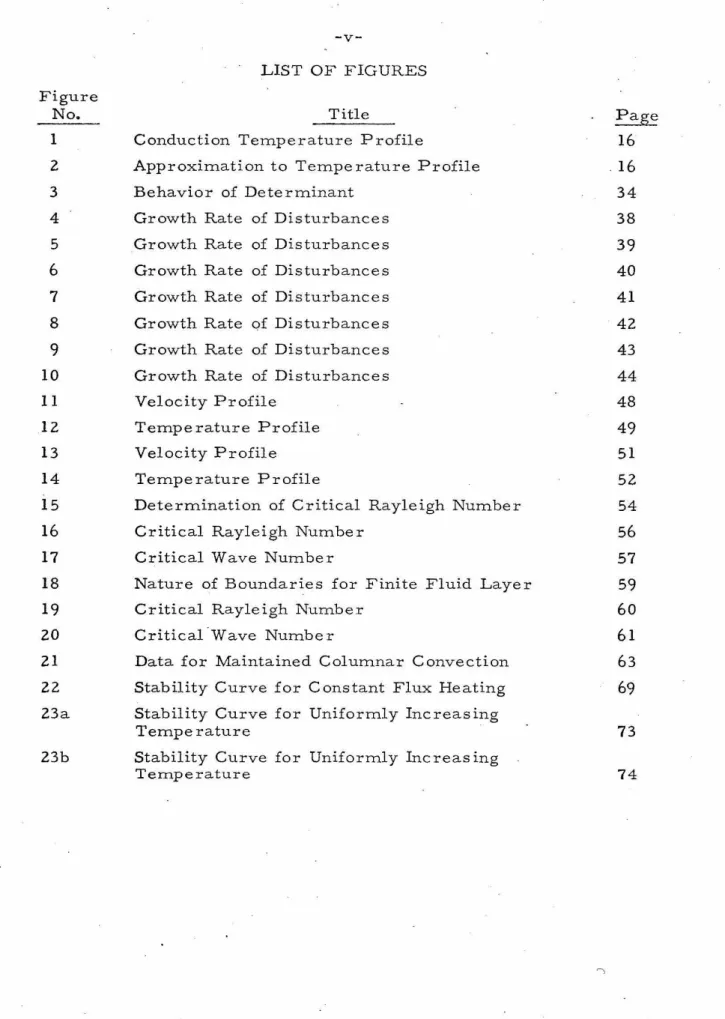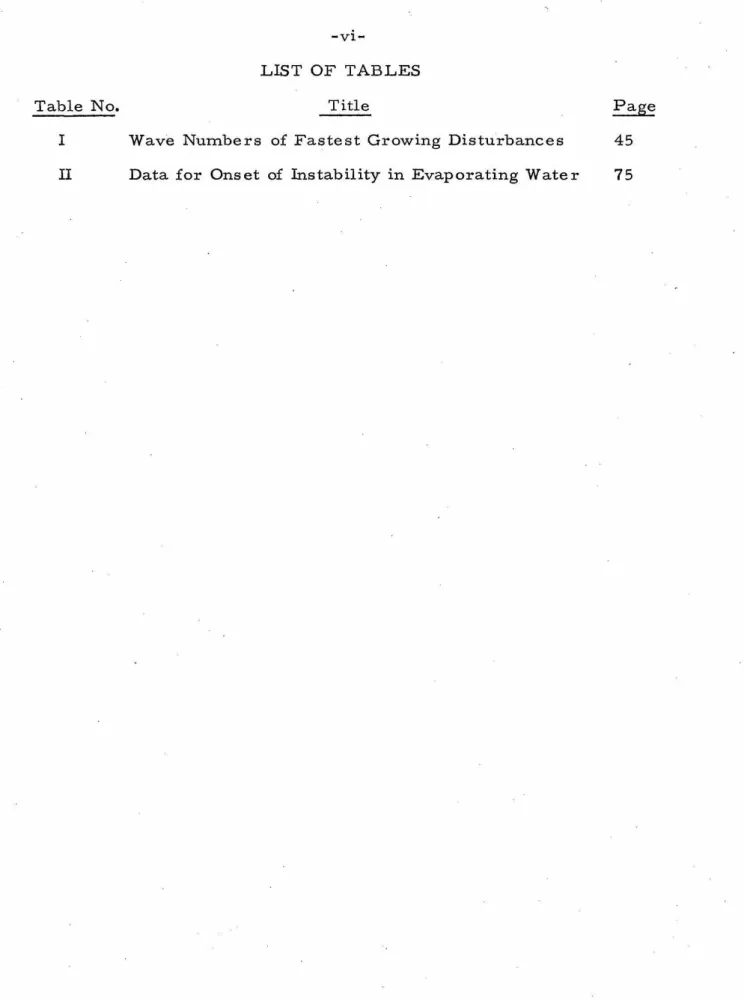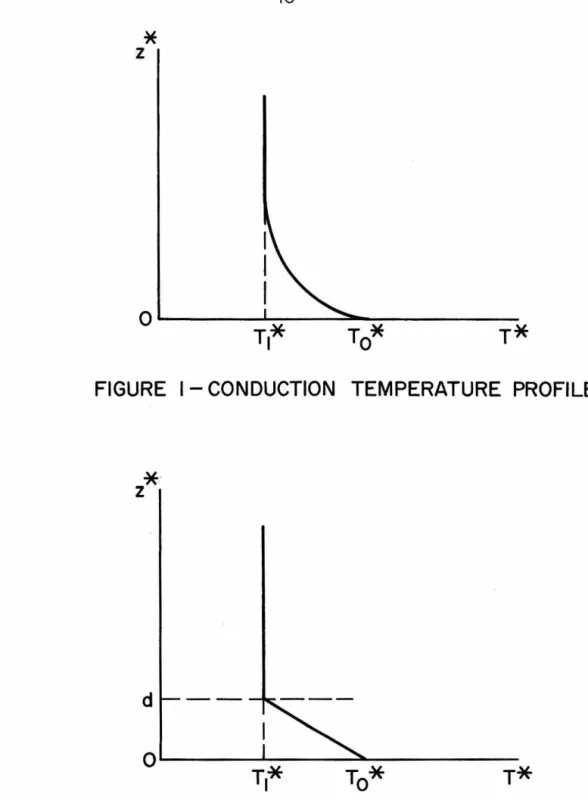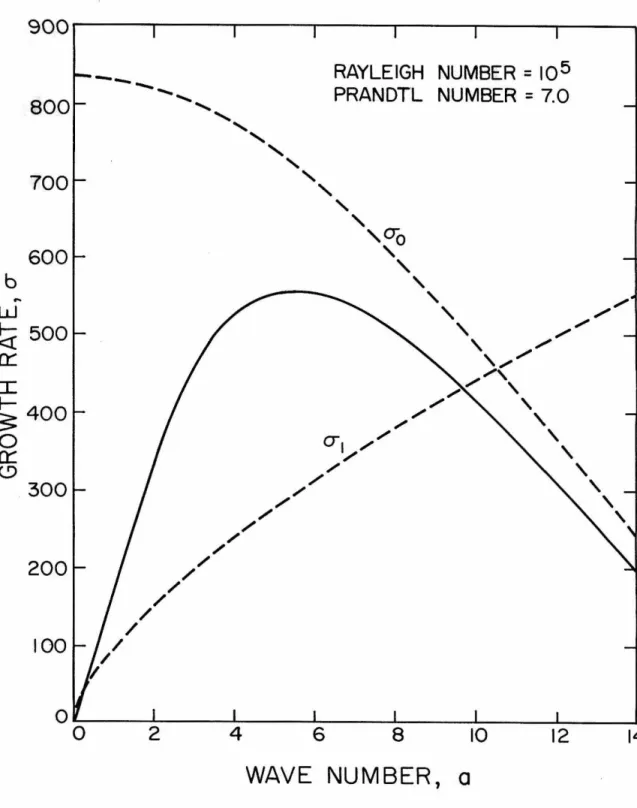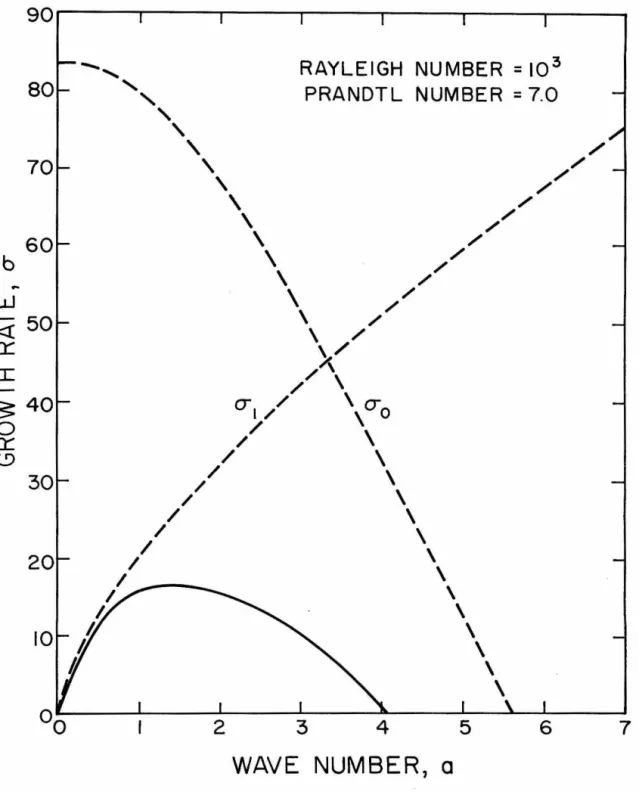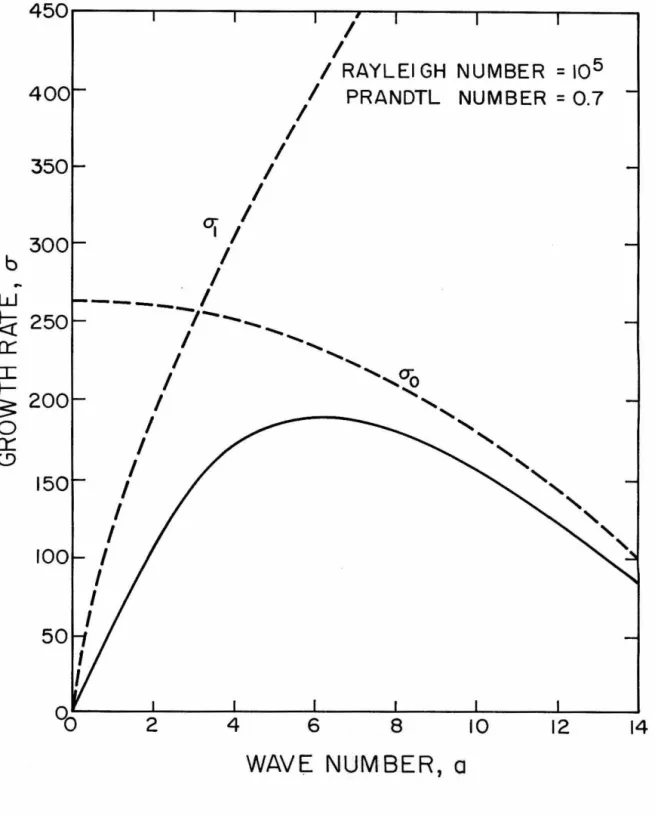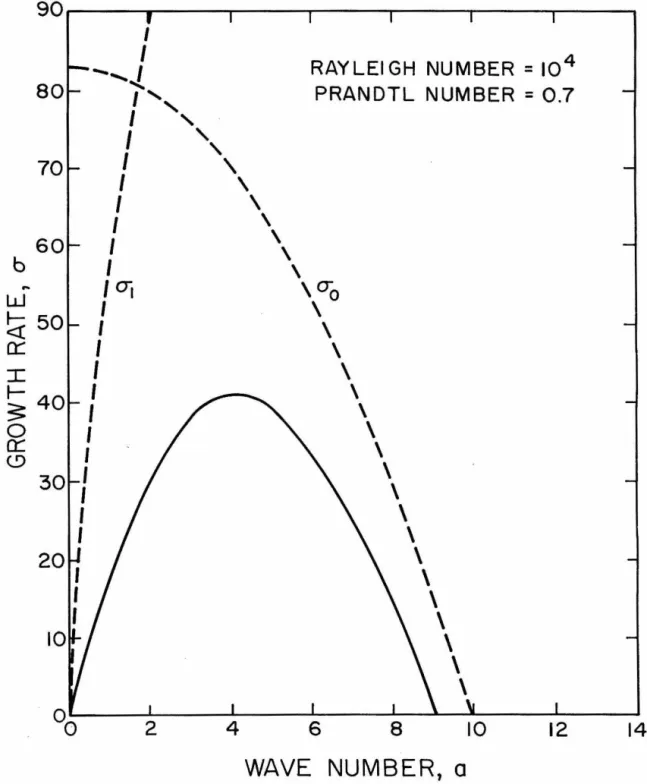The minimum critical Rayleigh number, based on the depth of the liquid layer, is found to be 1340. The principle of exchange of constants is also established by Rayleigh for this case. Jeffreys showed that if the boundaries are considered rigid, the numerical value of the critical Rayleigh number becomes 1707.
The amplitude of the perturbations was also calculated by Gorkov (1958) and by Nakagawa (1960), and the rate of heat transfer was studied by Kuo {1961). The variation of viscosity with temperature was considered by Palm {1960) who found that the critical Rayleigh number was slightly less than for the case of constant viscosity.
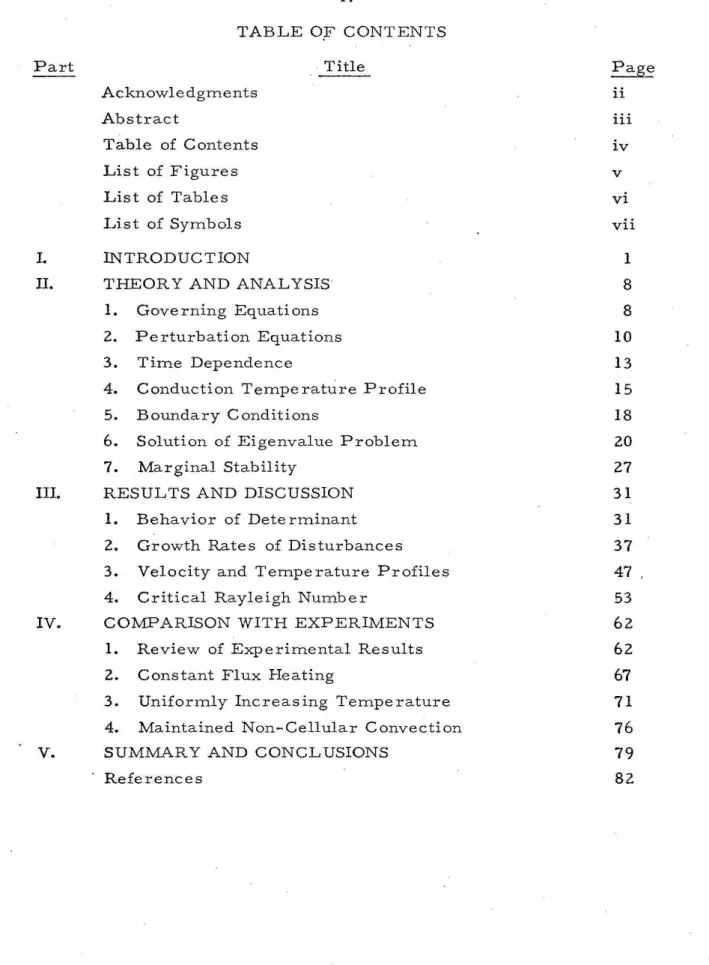
THEORY AND ANALYSIS 1. Gove ruing Equations
From solutions of the heat conduction equation, we know that the time required for the temperature profile to change by a factor of l/e is dz/x. It is only when the results of the analysis are applied to the physical problem that the constraint. That is, the value of the determinant is given by the product of all the differences (x.-x.} for which j The values of a for which the determinant is zero are the desired eigenvalues of the problem. The constant c9, and thus the amplitude· of the perturbations, is undetermined in the linear theory. The eigenvalues here are values of the Rayleigh number and they are obtained by iteration. The simplest method of finding the corresponding values of a is to observe that the general solution when y. Again, the exact solution shows that 1 are the most useful, because they play an important role in the behavior of the determinant near the greatest self-esteem. Since the determinant is generally complex, it might seem that to make both the real and imaginary parts vanish at the same time, we need two parameters. That is, one could assume that a is complex and that both the real and imaginary parts of a need to be adjusted to reduce the determinant to zero. However, it has been found that the roots of the determinant (45) can be found by considering .real. This means that the stability exchange principle applies here as well, as in uniform density stratification, except that it is represented numerically. The fact that a is real means that the perturbations will grow aperiodically in time, which is consistent with physical observations. 1 the y1's are all true and, since the A's are always true, the determinant itself is true. DETERMINANT I REAL)~ In this case the determinant is complex, but both the real and imaginary parts vanish for the same values of a. 1's are real, the imaginary nature must come from y1 • We have already shown that in this interval 'Yi is purely imaginary, so writing 'Yi ::: iy. In the first of these four determinants, we enter only the real parts of columns one and four. Since these real parts are identical, this determinant will have two identical columns, and therefore its nurrie value will be zero. In the second determinant we enter only the imaginary parts of columns one and four. The remaining two determinants will contain the real part of column one with the imaginary part of column four and vice versa. The factor -1 arises because the imaginary parts of columns one and four have opposite signs. For values less than a 1, the real and imaginary parts of the determinant are of the same order and in phase with each other, as shown in Figure 3. 0 • From this and the previous curves we conclude that the effect of increasing the Rayleigh number means increasing the growth rate of disturbances and the wave number at which the maximum growth rate occurs. These curves differ from the previous ones in so much that the solution curve O' never crosses the curve a 1• However, CJ is still an upper limit and as be-. The solution curves are shown in Figure 10 where they are all drawn to the same scale for comparison. PRANDTL NUMBER= 7.0 RAYLEIGH NUMBER= 10 4 PRANDTL NUMBER =7.0 I PRANDTL NUMBER = 0.7 RAYLEIGH NUMBER= 10 4 PRANDTL NUMBER = 0.7 PRANDTL NUMBER=~O Here the temperature disturbance is negative, which gives a reduced temperature profile and a greater local heat flux through the plane z = 0. Veronis (1958) has shown that the final amplitude effects are such that the net heat flux through the plane z = 0 is greater with convection than with conduction alone . If these are compared with Figures 11 and 12, it can be seen that the lower Prandtl number shifts the entire velocity curve towards the origin, so that the velocity does not penetrate so deeply. However, the temperature curve flattens so that the temperature is greater than that for P = 7.0, both in the region where dT/dz is positive and also where dT/dz is negative. With all this tendency for velocity and temperature penetrations to approach each other, there. PRANDTL NUMBER =0. 7 There is only one root of the determinant (61) that is not a real eigenvalue, and this happens when R = a 4. For a given wavenumber, there exists an infinite series of discrete values of R that reduce the determinant (61) to zero. These correspond to different forms of instability and are the counterpart to the infinite series of growth rates we encountered earlier. By definition of the critical Rayleigh number, we are interested in the numerically smallest value from this discrete set. For the lowest instability mode, there is a continuous spectrum of Rayleigh numbers that make the determinant of (61) equal to zero, one for each wavenumber. These solutions correspond to the points where the positive growth rate curves cross the line (] = 0. As we have already pointed out> it is the minimum value of R with respect to the wave number-a that gives the critical Rayleigh number. The variation of critical Rayleigh number with C is shown in Figure 16 , and the corresponding wavenumbers are presented in Figure 17 . For discussion of marginal stability of a finite fluid layer, it is convenient to use the Rayleigh number and the wave number on the . RECIPROCAL THICKNESS RATIO, I/~ 2 and z are non-dimensionalized by using h instead of d. From the above comparisons, we see that the results shown in Figures 16 and 17 apply to the situation depicted in Figure 18{a}, where the plane z = C is considered movable, while the results of Figures 19 and 20 directly apply to the situation shown in Figure 18{b}, where the plane z = e: is considered mobile. Although the results of Figures 16 to 20 could theoretically be obtained using any length scale, it was found that numerical problems arose in case {b} when e: became small. These problems are related to the numerically large values of R shown in Figure 19, .. c. for small e:, and leads to an undetermined value of R for the semi- c. infinite case. For a given heating method, the corresponding solution to the heat conduction equation will trace a path on figure 19, which for an initially isothermal liquid will start from the origin. The intersection of this heat conduction curve and the critical Rayleigh number curve will determine the actual critical Rayleigh number. EFFECTIVE DEPTH, E FIGURE 19-CRITICAL RAYLEIGH NUMBER EFFECTIVE DEPTH, E In order to be able to compare the results of the previous sections with the corresponding experimental results, a more detailed description of the aforementioned anomalies, including numerical data, will be presented here. Although Graham (1933) appears to have been the first to note the existence of a non-cellular mode of thermal convection, the first relevant data were published by Chandra (1938). The experiments conducted by Chandra involved a layer of air bounded above by a glass plate and below by a steel plate. Sidewalls were erected from the top surface so that water could be kept in contact with the glass. In this way, the boundary surfaces could be maintained at uniform, but different, temperatures while the movement of the liquid could be observed from above with the help of injected smoke. The temperature differences measured by Chandra, which correspond to sustained convection, are shown in Figure 21 together with the linear temperature profile theory. The stability of a fluid with a non-uniform and unfavorable temperature gradient has been analyzed for the response of infinitesimal perturbations. The following results have been established for the growth of disturbances in a semi-infinite fluid field. increases the growth rate and wave number of the fastest growing·. disturbance and the spectrum of wavenumbers of unstable disturbances. ii) Increasing the Prandtl number reduces the absolute growth rate of all perturbations but does not affect the spectrum of . iii). The velocity and temperature perturbations of the associated motion of these perturbations have certain characteristics as follows. iv). The velocity and temperature perturbations both penetrate deeper into the stable fluid region at smaller values of the supercritical Rayleigh number. v). In a finite fluid layer, the effect of the heating rate may be to slightly reduce the critical Rayleigh number R=. in close agreement with experimental observations. The stability of an initially isothermal finite fluid layer under constant flux heating was investigated. The Rayleigh number is increased and continues to increase indefinitely as the heating rate increases. A finite fluid layer whose lower surface temperature increases uniformly with time was also studied, and the results are consistent with experiments. The Rayleigh number is increased and continues to increase indefinitely as the heating rate increases. Vortex cellulaires dans une couche fluide qui transportent la chaleur par convection en régime permanent. À propos des courants de convection dans une couche liquide horizontale lorsque la température la plus élevée est au fond.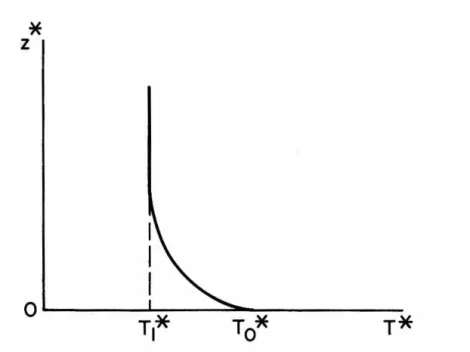
RESULTS AND DISCUSSION 1. Behavior of Determinant
DETERMINANT (IMAGINARY)
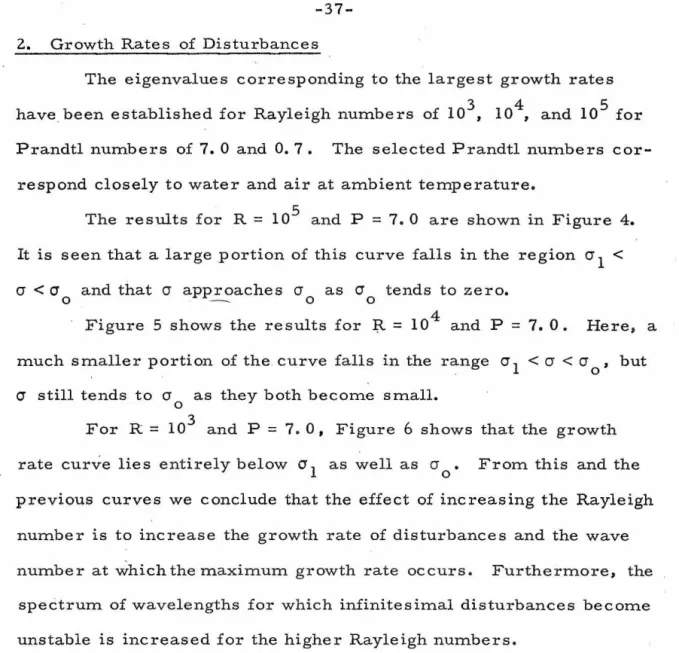
PRANDTL NUMBER =7.0
PRANDTL NUMBER= 0.1
FIXED
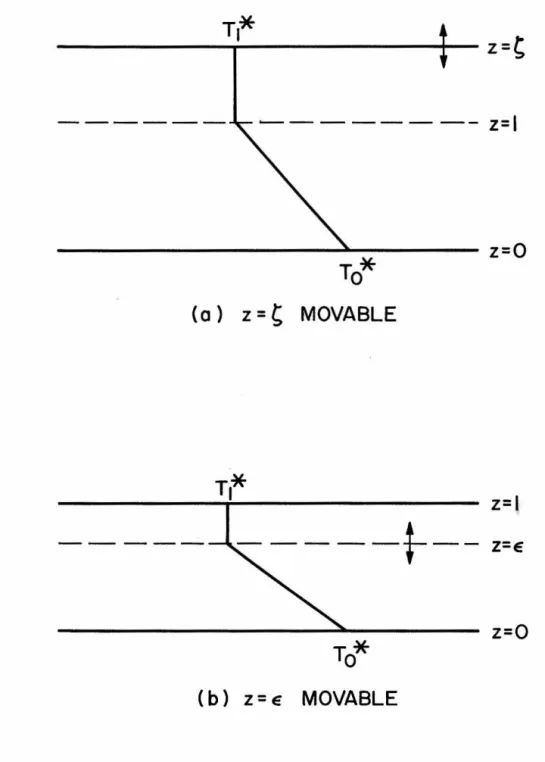
FI GURE 20- CRITICAL WAVE NUMBER
CO:MPARISON WITH EXPERIMENTS 1. Review of Experimental Results
LINEAR PROFILE THEORY
SUMMARY AND CONCLUSIONS
